Year 893 (DCCCXCIII) was a common year starting on Monday of the Julian calendar.

Earthquakes are caused by movements within the Earth's crust and uppermost mantle. They range from weak events detectable only by seismometers, to sudden and violent events lasting many minutes which have caused some of the greatest disasters in human history. Below, earthquakes are listed by period, region or country, year, magnitude, cost, fatalities and number of scientific studies.

Abū al-ʿAbbās Aḥmad ibn Muḥammad ibn Kathīr al-Farghānī also known as Alfraganus in the West, was an astronomer in the Abbasid court in Baghdad, and one of the most famous astronomers in the 9th century. Al-Farghani composed several works on astronomy and astronomical equipment that were widely distributed in Arabic and Latin and were influential to many scientists. His best known work, Kitāb fī Jawāmiʿ ʿIlm al-Nujūmi, was an extensive summary of Ptolemy's Almagest containing revised and more accurate experimental data. Christopher Columbus used Al Farghani's calculations for his voyages to America. In addition to making substantial contributions to astronomy, al-Farghani also worked as an engineer, supervising construction projects on rivers in Cairo, Egypt. The lunar crater Alfraganus is named after him.
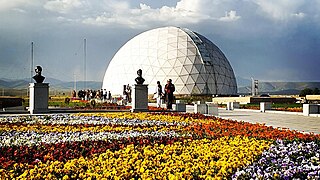
Maragheh is a city in the Central District of Maragheh County, East Azerbaijan province, Iran, serving as capital of both the county and the district.
The Battle of Garni was fought in 1225 near Garni, in modern day Armenia, then part of the Kingdom of Georgia. The invading Khwarazmian Empire was led by Jalal al-Din Mangburni, its last Sultan, who was driven from his realm by the Mongol Empire and was trying to recapture lost territories. The battle ended with a Khwarezmid victory and is marked as a disastrous event in Georgian history due to betrayal. As a result, the royal court of Georgian Queen Rusudan (1223–1245) moved to Kutaisi and the country was exposed to subsequent looting during the Mongol invasions of Georgia.

The Shaddadids were a Sunni Muslim dynasty of Kurdish origin. who ruled in various parts of Armenia and Arran from 951 to 1199 AD. They were established in Dvin. Through their long tenure in Armenia, they often intermarried with the Bagratuni royal family of Armenia.

Dvin was a large commercial city and the capital of early medieval Armenia. It was situated north of the previous ancient capital of Armenia, the city of Artaxata, along the banks of the Metsamor River, 35 km to the south of modern Yerevan. It is claimed it was one of the largest cities east of Constantinople prior to its destruction by the Mongols in the 13th century, but with an overall area of approximately 1sqkm, it was far smaller than many of the great cities of Asia.

Rawwadid, Ravvadid, or Banū Rawwād (955–1071) was a Sunni Muslim Kurdish dynasty, centered in the northwestern region of Adharbayjan (Azerbaijan) between the late 8th and early 13th centuries.

The Ildegizids, Eldiguzids or Ildenizids, also known as Atabegs of Azerbaijan were an Atabegate of the Seljuk Empire, and a Sunni Muslim Turkic dynasty, which controlled most of northwestern Persia, eastern Transcaucasia, including Arran, most of Azerbaijan, and Djibal. At their maximum extent, the territory under their control, roughly corresponds to most of north-western Iran, most of the regions of modern Azerbaijan and smaller portions in modern Armenia, Turkey and Iraq. Down to the death in war 1194 of Toghril b. Arslan, last of the Great Seljuq rulers of Iraq and Persia, the Ildenizids ruled as theoretical subordinates of the Sultans, acknowledging this dependence on their coins almost down to the end of the Seljuqs. Thereafter, they were in effect an independent dynasty, until the westward expansion of the Mongols and the Khwarazm-Shahs weakened and then brought the line to its close.
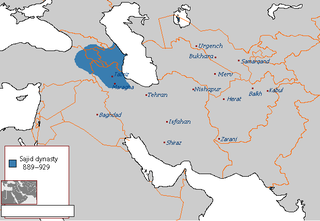
The Sajid dynasty, was an Iranian Muslim dynasty that ruled from 889/890 until 929. The Sajids ruled Azerbaijan and parts of Armenia first from Maragha and Barda and then from Ardabil. The Sajids originated from the Central Asian province of Ushrusana and were of Iranian (Sogdian) descent. Muhammad ibn Abi'l-Saj Diwdad the son of Diwdad, the first Sajid ruler of Azerbaijan, was appointed as its ruler in 889 or 890. Muhammad's father Abu'l-Saj Devdad had fought under the Ushrusanan prince Afshin Khaydar during the latter's final campaign against the rebel Babak Khorramdin in Azerbaijan, and later served the caliphs. Toward the end of the 9th century, as the central authority of the Abbasid Caliphate weakened, Muhammad was able to form a virtually independent state. Much of the Sajids' energies were spent in attempting to take control of neighboring Armenia. The dynasty ended with the death of Abu'l-Musafir al-Fath in 929.
Muhammad ibn Abi'l-Saj also known as Muhammad al-Afshin, an Iranian appointed general of al-Mu'tadid, He was the founder of Sajid dynasty and governor of Azerbaijan, from 889 or 890 until his death. He was the son of Abi'l-Saj Devdad.

Yusuf ibn Abi'l Saj was the Sajid amir of Azerbaijan from 901 until his death. He was the son of Abi'l-Saj Devdad.

The Sallarid dynasty, was a Muslim dynasty of Daylami origin, which ruled in Tarom, Samiran, Daylam, Gilan and subsequently Azerbaijan, Arran, and some districts in Eastern Armenia in the 2nd half of the 10th century. They constitute part of the period in history that has been named the Iranian Intermezzo, a period that saw the rise of native Iranian dynasties during the 9th to the 11th centuries.
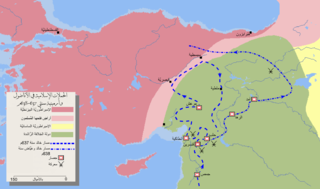
The Muslim conquest of Armenia was a part of the Muslim conquests after the death of the Islamic prophet Muhammad in 632 CE. Persarmenia had fallen to the Arab Rashidun Caliphate by 645 CE. Byzantine Armenia was already conquered in 638–639.
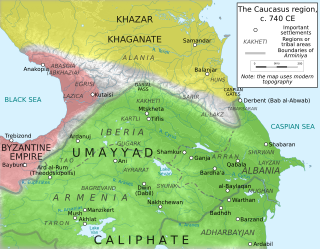
Arminiya, also known as the Ostikanate of Arminiya or the Emirate of Armenia, was a political and geographic designation given by the Muslim Arabs to the lands of Greater Armenia, Caucasian Iberia, and Caucasian Albania, following their conquest of these regions in the 7th century. Though the caliphs initially permitted an Armenian prince to represent the province of Arminiya in exchange for tribute and the Armenians' loyalty during times of war, Caliph Abd al-Malik ibn Marwan introduced direct Arab rule of the region, headed by an ostikan with his capital in Dvin. According to the historian Stephen H. Rapp in the third edition of the Encyclopaedia of Islam:
Early Arabs followed Sāsānian, Parthian Arsacid, and ultimately Achaemenid practice by organising most of southern Caucasia into a large regional zone called Armīniya.

The 856 Damghan earthquake or the 856 Qumis earthquake occurred on 22 December 856. The earthquake had an estimated magnitude of 7.9, and a maximum intensity of X (Extreme) on the Mercalli intensity scale. The meizoseismal area extended for about 350 kilometres (220 mi) along the southern edge of the eastern Alborz mountains of present-day Iran including parts of Tabaristan and Gorgan. The earthquake's epicenter is estimated to be close to the city of Damghan, which was then the capital of the Persian province of Qumis. It caused approximately 200,000 deaths and is listed by the USGS as the sixth deadliest earthquake in recorded history. This death toll has been debated.

Al-Bidāya wa l-Nihāya, sometimes also known as the Tārīkh Ibn Kathīr, is a work on Islamic history by the Sunni Muslim scholar Ibn Kathir.
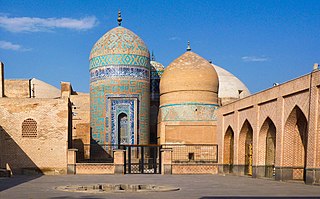
Ardabil is a city in northwestern Iran. It is in the Central District of Ardabil County, Ardabil province, Iran, serving as capital of the province, the county, and the district. The official language is Persian like the rest of Iran and the majority language is Azerbaijani.
The 893 Dvin earthquake occurred on 28 December at around midnight. It had a magnitude of approximately 6 and a maximum intensity of approximately IX (Violent) on the Mercalli intensity scale. It destroyed the city of Dvin in Armenia, causing approximately 30,000 casualties. The similarity of the Arabic name for Dvin, 'Dabil' to Ardabil in northwestern Iran, has caused confusion in written records, such that the 893 Ardabil earthquake appears in several catalogues, although it is generally regarded as a false event. It was also recorded as an event during the classical period of India in several early catalogues at an unspecified capital.
Ibrahim I ibn Marzuban I was the Sallarid ruler of Dvin (957–979) and later Azerbaijan. He was the son and successor of Marzuban ibn Muhammad.















